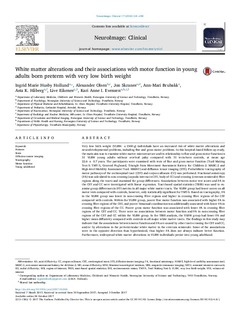| dc.contributor.author | Hollund, Ingrid Marie Husby | |
| dc.contributor.author | Olsen, Alexander | |
| dc.contributor.author | Skranes, Jon Sverre | |
| dc.contributor.author | Brubakk, Ann-Mari | |
| dc.contributor.author | Håberg, Asta | |
| dc.contributor.author | Eikenes, Live | |
| dc.contributor.author | Evensen, Kari Anne Indredavik | |
| dc.date.accessioned | 2018-02-01T15:11:22Z | |
| dc.date.available | 2018-02-01T15:11:22Z | |
| dc.date.created | 2018-01-03T10:46:26Z | |
| dc.date.issued | 2017 | |
| dc.identifier.citation | NeuroImage: Clinical. 2017, 17 241-250. | nb_NO |
| dc.identifier.issn | 2213-1582 | |
| dc.identifier.uri | http://hdl.handle.net/11250/2482043 | |
| dc.description.abstract | Very low birth weight (VLBW: ≤ 1500 g) individuals have an increased risk of white matter alterations and neurodevelopmental problems, including fine and gross motor problems. In this hospital-based follow-up study, the main aim was to examine white matter microstructure and its relationship to fine and gross motor function in 31 VLBW young adults without cerebral palsy compared with 31 term-born controls, at mean age 22.6 ± 0.7 years. The participants were examined with tests of fine and gross motor function (Trail Making Test-5: TMT-5, Grooved Pegboard, Triangle from Movement Assessment Battery for Children-2: MABC-2 and High-level Mobility Assessment Tool: HiMAT) and diffusion tensor imaging (DTI). Probabilistic tractography of motor pathways of the corticospinal tract (CST) and corpus callosum (CC) was performed. Fractional anisotropy (FA) was calculated in non-crossing (capsula interna in CST, body of CC) and crossing (centrum semiovale) fibre regions along the tracts and examined for group differences. Associations between motor test scores and FA in the CST and CC were investigated with linear regression. Tract-based spatial statistics (TBSS) was used to examine group differences in DTI metrics in all major white matter tracts. The VLBW group had lower scores on all motor tests compared with controls, however, only statistically significant for TMT-5. Based on tractography, FA in the VLBW group was lower in non-crossing fibre regions and higher in crossing fibre regions of the CST compared with controls. Within the VLBW group, poorer fine motor function was associated with higher FA in crossing fibre regions of the CST, and poorer bimanual coordination was additionally associated with lower FA in crossing fibre regions of the CC. Poorer gross motor function was associated with lower FA in crossing fibre regions of the CST and CC. There were no associations between motor function and FA in non-crossing fibre regions of the CST and CC within the VLBW group. In the TBSS analysis, the VLBW group had lower FA and higher mean diffusivity compared with controls in all major white matter tracts. The findings in this study may indicate that the associations between motor function and FA are caused by other tracts crossing the CST and CC, and/or by alterations in the periventricular white matter in the centrum semiovale. Some of the associations were in the opposite direction than hypothesized, thus higher FA does not always indicate better function. Furthermore, widespread white matter alterations in VLBW individuals persist into young adulthood. | nb_NO |
| dc.language.iso | eng | nb_NO |
| dc.publisher | Elsevier | nb_NO |
| dc.rights | Attribution-NonCommercial-NoDerivatives 4.0 Internasjonal | * |
| dc.rights.uri | http://creativecommons.org/licenses/by-nc-nd/4.0/deed.no | * |
| dc.title | White matter alterations and their associations with motor function in young adults born preterm with very low birth weight. | nb_NO |
| dc.type | Journal article | nb_NO |
| dc.type | Peer reviewed | nb_NO |
| dc.description.version | publishedVersion | nb_NO |
| dc.source.pagenumber | 241-250 | nb_NO |
| dc.source.volume | 17 | nb_NO |
| dc.source.journal | NeuroImage: Clinical | nb_NO |
| dc.identifier.doi | 10.1016/j.nicl.2017.10.006 | |
| dc.identifier.cristin | 1534480 | |
| dc.description.localcode | © 2017 The Authors. Published by Elsevier Inc. This is an open access article under the CC BY-NC-ND license (http://creativecommons.org/licenses/BY-NC-ND/4.0/). | nb_NO |
| cristin.unitcode | 194,65,15,0 | |
| cristin.unitcode | 194,67,40,0 | |
| cristin.unitcode | 194,65,30,0 | |
| cristin.unitcode | 194,65,25,0 | |
| cristin.unitcode | 194,65,20,0 | |
| cristin.unitname | Institutt for klinisk og molekylær medisin | |
| cristin.unitname | Institutt for psykologi | |
| cristin.unitname | Institutt for nevromedisin og bevegelsesvitenskap | |
| cristin.unitname | Institutt for sirkulasjon og bildediagnostikk | |
| cristin.unitname | Institutt for samfunnsmedisin og sykepleie | |
| cristin.ispublished | true | |
| cristin.fulltext | original | |
| cristin.qualitycode | 1 | |

